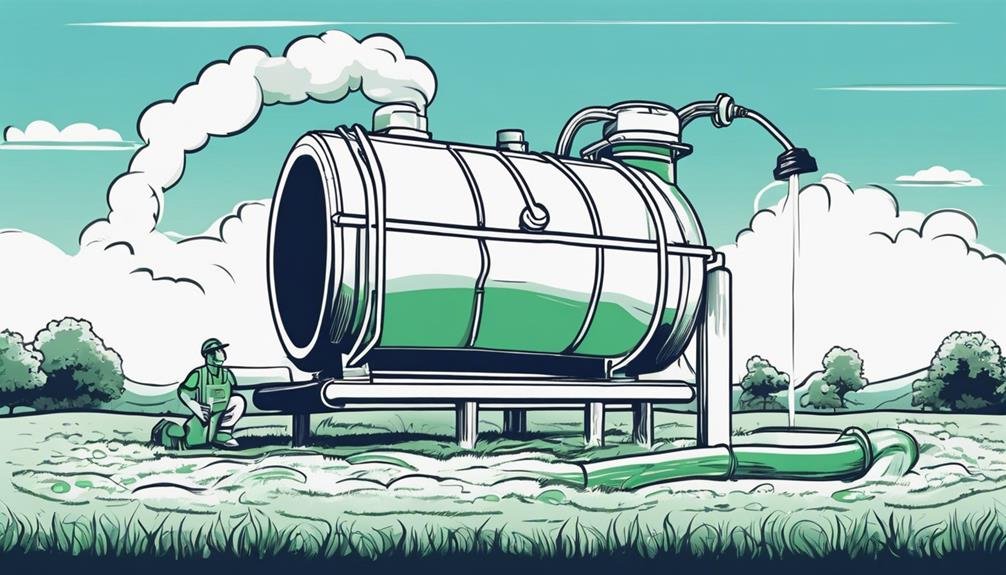You might think maintaining a septic tank is a hassle, but with a concise checklist, it's more manageable than you think. Regular pumping is crucial, but did you know there are other key steps to keep your system running smoothly?
From inspecting the drainfield to monitoring water usage, each task plays a vital role in preventing costly issues down the line. But, there's one more essential aspect often overlooked that could save you from potential headaches.
Key Takeaways
- Regular pump-outs every 3-5 years prevent backups and system overload.
- Drainfield inspections detect issues early, preventing costly repairs.
- Monitor water usage to prevent tank overload and conserve water.
- Proper waste disposal preserves system health and functionality.
Importance of Regular Pumping

Why is regular pumping of your septic tank crucial for its proper functioning?
Septic tanks require routine maintenance to prevent backups, clogs, and system failures. By scheduling regular pump-outs every 3 to 5 years, depending on household size and water usage, you ensure that solid waste buildup is kept in check. During these pump-outs, professionals will also conduct a thorough inspection of the tank, checking for any signs of damage, leaks, or structural issues. Tank inspection is essential to catch any problems early on before they escalate and become costly repairs.
Frequency scheduling is key to preventing overloading of the septic system, which can lead to sewage backing up into your home or yard. Neglecting regular pumping can result in unpleasant odors, slow drainage, and even sewage seeping into the ground. Investing in maintenance now will save you from major headaches down the line. Remember, a well-maintained septic tank is a happy septic tank!
Inspecting the Drainfield
Inspecting the drainfield is a critical aspect of septic tank maintenance to ensure proper functioning and prevent potential issues. The drainfield plays a vital role in the septic system by filtering and treating wastewater before it seeps into the ground. To maintain drainfield health, regularly check for any signs of standing water or unusually lush vegetation, as these could indicate problems like soil saturation. Inspecting the area allows you to catch issues early on, preventing costly repairs or replacements down the line.
Soil saturation is a key factor to monitor during drainfield inspections. If the soil becomes oversaturated with wastewater, it can lead to backups, foul odors, and even sewage surfacing above ground. By keeping an eye on soil saturation levels, you can take proactive steps to address any drainage issues before they escalate. Inspecting the drainfield is a simple yet effective way to ensure that your septic system continues to operate smoothly and efficiently.
Monitoring Water Usage
To ensure the optimal performance of your septic system, closely monitoring water usage is a crucial practice that can help prevent potential issues and maintain the system's efficiency over time. Tracking leaks is essential as even small leaks can lead to significant water wastage and overload your septic tank, causing issues down the line. Keep an eye out for dripping faucets, running toilets, or unexpected increases in your water bill, as these could indicate a leak that needs prompt attention.
Conserving water is another vital aspect of septic system maintenance. Be mindful of your water usage habits, such as taking shorter showers, fixing any leaks promptly, and running full loads of laundry and dishes. By being conscious of your water consumption, you can reduce the strain on your septic system and help it operate smoothly for longer periods.
Proper Disposal Practices
Proper disposal practices play a critical role in maintaining the functionality and longevity of your septic system. Waste management is key to ensuring that your septic tank operates efficiently. Avoid flushing non-biodegradable items such as wipes, feminine products, or paper towels, as they can clog the system and lead to backups. Grease and oils should also be disposed of properly, as they can solidify in the tank and cause blockages. Opt for environmentally friendly cleaning products to minimize the impact on your septic system and the surrounding ecosystem.
When doing laundry, use phosphate-free detergents to prevent excess nutrients from entering the system, which can disrupt the natural balance within the tank. Be mindful of the chemicals you pour down the drain, as harsh substances can kill the beneficial bacteria that break down waste in the septic tank. By adopting responsible waste disposal practices, you not only maintain the health of your septic system but also reduce your environmental impact.
Frequently Asked Questions
How Often Should Septic Tank Additives Be Used and Are They Necessary for Proper Maintenance?
You should use septic tank additives sparingly; they aren't always necessary for maintenance. Their effectiveness varies, so consult a professional. Regular septic tank pumping is essential, typically every 3-5 years, to keep your system running smoothly.
Are There Any Warning Signs That Homeowners Should Look Out for to Indicate a Potential Septic Tank Issue?
When it comes to septic tanks, staying vigilant is key. Watch for signs like drainfield saturation and foul odors. If you notice these, it's time to call in the experts to prevent bigger problems.
Can Landscaping or Heavy Objects Placed on Top of the Drainfield Cause Damage to the Septic System?
Protect your drainfield by avoiding heavy objects on it. Landscaping should not interfere with the septic system. Exceeding weight limits or obstructing the area can lead to damage. Be mindful of what goes on top.
What Is the Average Lifespan of a Septic Tank and How Can Homeowners Extend Its Longevity?
To extend your septic tank's lifespan, regular maintenance is key. Pumping every 3-5 years, avoiding excessive water usage, proper waste disposal, and inspection can help. Address issues promptly to prevent costly repairs and ensure longevity.
Is It Recommended to Have a Professional Inspection Done on the Septic System Before Purchasing a New Home?
When buying a new home, DIY inspections are like shining a light in the dark – revealing hidden truths. Yet, for peace of mind, a professional inspection is key; a homebuyer's responsibility to ensure a sound investment.
Conclusion
In conclusion, keeping up with septic tank maintenance is like tending to a delicate garden – regular care and attention are essential for its health and longevity.
By following the essential maintenance checklist, such as regular pumping, inspecting the drainfield, monitoring water usage, and practicing proper disposal habits, you can ensure your septic system continues to function efficiently and effectively.
Remember, just like a garden, a well-maintained septic tank will flourish and provide years of reliable service.

